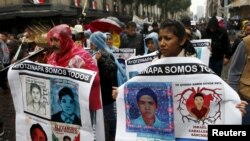A year-long independent investigation into the disappearance of 43 students in Mexico has failed to determine what happened to the young men, in the face of what researchers call "obstructions" by government authorities.
A five-member panel appointed by the Inter-American Commission on Human Rights -- an autonomous arm of the Organization of American States -- issued its final report Sunday, in a case that has rocked the country and drawn international attention.
The team arrived in March 2015 to Iguala, in the southern state of Guerrero. It was the last place the students, who attended the Ayotzinapa Rural Teachers' College, were seen in public on September 26, 2014. They have not been heard from since.
According to the government, local police detained the students after they hijacked buses to attend a protest. They then turned the men over to the Guerreros Unidos drug gang that burned their bodies in a nearby garbage dump.
But the public, especially the families of the missing, have questioned the official story and protested what they call a lack of transparency in the case.
Last September, the IACHR experts also rejected the government's theory, saying there is no scientific proof that an immense fire took place at the landfill in the neighboring town of Cocula.
The 605-page report released Sunday falls short of claiming that federal police and soldiers were directly involved in the mass disappearance, but it notes that they were present at different locations that night.
The panel said Mexican authorities showed "little interest" in moving forward with new lines of investigation, blocked them from re-interviewing suspects, and attempted to discredit the IACHR investigation. It also noted that a study of 17 of the approximately 110 suspects detained in the case revealed signs of beatings.






